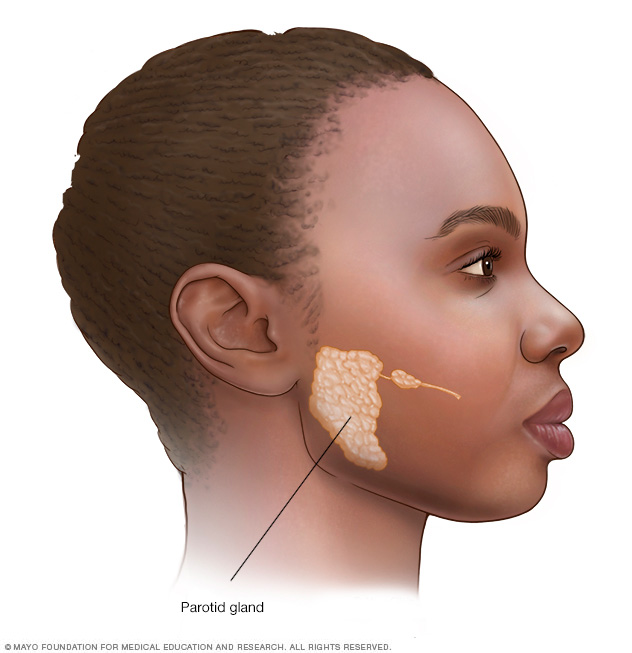Parotid tumors are abnormal growths of cells (tumors) that form in the parotid glands. The parotid glands are two salivary glands that sit just in front of the ears on each side of the face. Salivary glands produce saliva to aid in chewing and digesting food.
There are many salivary glands in the lips, cheeks, mouth and throat. Tumors can occur in any of these glands, but the parotid glands are the most common location for salivary gland tumors. Most parotid tumors are noncancerous (benign), though some tumors can become cancerous.
Parotid tumors often cause swelling in the face or jaw that usually isn't painful. Other symptoms include numbness, burning or prickling sensations in the face, or a loss of facial movement.
Parotid tumor treatment is usually with surgery to remove the tumor. If the tumor contains cancer cells, additional treatments might be recommended.

The parotid glands are one set of three pairs of major salivary glands. Each set of glands has its own tube (duct) leading from the gland to the mouth.
Diagnosis
Tests and procedures used to diagnose a parotid tumor may include:
- A physical exam. Your doctor will feel your jaw, neck and throat for lumps or swelling.
-
Collecting a sample of tissue for testing (biopsy). Your doctor may recommend a needle biopsy procedure, such as fine-needle aspiration or core needle biopsy, to collect a sample of tissue for testing. During a needle biopsy, the doctor inserts a thin needle through your skin and into the affected parotid gland. The needle is used to draw out a sample of cells or fluid.
In the lab, doctors can determine what types of cells are involved and whether they're cancerous. Your doctor uses this information to determine your prognosis and which treatments are best for you.
- Imaging tests. Your doctor may recommend imaging tests of your parotid gland to help understand the size of your tumor. If your parotid tumor is cancerous, you may need tests to look for signs that the cancer has spread. Tests may include ultrasound, MRI and CT.
Treatment
Parotid tumor treatment usually involves surgery to remove the tumor. If the tumor contains cancer cells, your doctor may recommend additional treatments, such as radiation therapy and chemotherapy.
Surgery
Operations used to remove parotid tumors include:
- Removing part of the parotid gland. For most parotid tumors, surgeons may cut away the tumor and some of the healthy parotid gland tissue around it (superficial parotidectomy).
- Removing all of the parotid gland. Surgery to remove all of the parotid gland (total parotidectomy) might be recommended for larger tumors and those that affect the deeper parts of the parotid gland.
- More extensive surgery for larger cancers. If parotid cancer has grown into nearby bone and muscles, a more extensive operation may be necessary. Surgeons try to remove all of the cancer and a small amount of the healthy tissue that surrounds it. Then they work to repair the area so you can continue to chew, swallow, speak, breathe and move your face. This may involve transferring skin, tissue, bone or nerves from other parts of your body to make repairs.
To access the parotid gland, surgeons make an incision near the ear. During the operation, special care is taken to avoid damage to nearby structures, such as the facial nerve that runs through the parotid gland. The facial nerve controls facial movement, so stretching or cutting the nerve can cause partial or complete paralysis of the face that can be temporary or permanent.
If the facial nerve must be cut in order to remove all of the tumor, surgeons can repair it using nerves from other areas of your body or processed nerve grafts from donors.
Radiation therapy
Radiation therapy uses powerful beams of energy, such as X-rays, protons or neutrons, to kill cancer cells. If your parotid tumor is cancerous, radiation therapy might be recommended after surgery to kill any cancer cells that remain. Radiation therapy is sometimes used as an initial treatment when surgery isn't an option.
Chemotherapy
Chemotherapy is a drug treatment that uses medications to kill cancer cells. It's not routinely used to treat parotid tumors. But sometimes it's combined with radiation therapy to treat parotid cancers that have a high risk of spreading or cancers that can't be removed completely with surgery. Chemotherapy might also be an option for people with advanced parotid cancers that have spread to other parts of the body.
Copyright © 1998-2025 Mayo Foundation for Medical Education and Research (MFMER). All rights reserved.